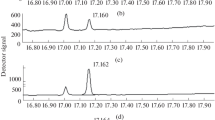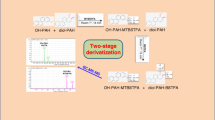Summary
An automated high performance liquid chromatographic method (HPLC) for the direct determination of urinary concentrations of hippuric acid (HA), and o-, m- and p-methyl hippuric acids (MHAs), metabolites of toluene and o-, m-, and p-xylenes, and of urinary phenyl glyoxylic acid (PGA) and mandelic acid (MA), metabolites of styrene or ethylbenzene, is described. Methanol was added to urine, the mixture was centrifuged and the supernatant was injected into HPLC. A stainless-steel column packed with octadecyl silanized silicate was used and the mobile phase was a mixed solution of 5 mM potassium phosphate monobasic/acetonitrile (90/10). The method is simple and specific. Urine can be analyzed without solvent extraction. Analysis can be performed satisfactorily within 45 min for samples containing HA, MHAs, PGA and MA, and within 15 min for those containing HA, PGA and MA. Another automated HPLC method for the determination of urinary concentrations of phenylsulfate (PhS) and phenylglucuronide (PhG), metabolites of benzene and phenol, is also described. Urine was centrifuged and the supernatant was injected into HPLC. A column packed with octadecyl silicate and a mobile phase of 50 mM of potassium phosphate monobasic/acetonitrile (85/15) were used. The whole analyses and quantitative determination can be performed within 15 min for samples containing PhS and PhG in the worker's urine with a simple mobile phase. The accuracy and precision in the present methods by the use of automated HPLC were satisfactory.
Similar content being viewed by others
References
ACGIH (1985) Biological exposure indices committees: threshold limit values for chemical substances in the work environment and biological exposure indices with intended changes for 1985–1986
Bardodej Z, Bardodejova E (1970) Biotransformation of ethylbenzene, styrene and alphamethylstyrene in man. Am Ind Hyg Assoc J 31:206–209
Gerade HW (1960) Toxicology and biochemistry of aromatic hydrocarbons. Elsevier, Amsterdam London New York Princeton, pp 171–180
German Research Society (1985) (Commission for the investigation of Health Hazards of Chemical Compounds in the Work Area) Maximum concentrations at the workplace and biological tolerance values for working materials, pp 76—77
Hunter CG, Blair D (1972) Benzene: pharmacokinetic studies in man. Ann Occup Hyg 15:193
Kira S (1977) Measurement by gas chromatography of urinary hippuric acid and methylhippuric acid as indices of toluene and xylene exposure. Br J Ind Med 34:305–309
Ogata M, Tomokuni K, Takatsuka Y (1961) Quantitative determination in urine of hippuric acid and m- or p-methylhippuric acid, metabolites of toluene and m- or p-xylene. Br J Ind Med 26:330–334
Ogata M, Sugihara R (1978) High performance liquid chromatographic procedure for quantitative determination of urinary phenyl glyoxylic, mandelic and hippuric acids as indices of styrene exposure. Int Arch Occup Environ Health 42:11–19
Ogata M, Yamazaki Y (1979) High performance liquid chromatography for the quantitative determination of urinary phenylsulfate and phenylglucuronide as indices of benzene and phenol exposure in rats. Int Arch Occup Environ Health 44:177–184
Ogata M, Taguchi T (1986) Quantitative analysis of urinary glycine conjugates by high performance liquid chromatography: excretion of hippuric acid and methyl hippuric acids in the urine of subjects exposed to vapors of toluene and xylenes. Int Arch Occup Environ Health 58:121–129
Ogata M, Sugihara R, Kira S (1977) Quantitative determination of urinary hippuric acid and m- or p-methylhippuric acid as indices of toluene and n- or p-xylene exposure by high performance liquid chromatography. Int Arch Occup Environ Health 39:199–206
Ogata M, Yamazaki Y, Sugihara R (1980) Quantitation of urinary o-xylene metabolites of rats and human being by high performance liquid chromatography. Int Arch Occup Environ Health 46:127–139
Ogata M, Yamazaki Y, Kawai T (1986) Significance of urinary phenyl sulfate and phenyl glucuronide as indices of exposure to phenol. Int Arch Occup Environ Health 58:197–202
Parke DV, Williams RT (1953) Studies in detoxication. 54. The metabolism of benzene. (a) The formation of phenyl glucuronide and phenol sulphuric acid from [14C] benzene. (b) The metabolism of [14C] phenol. Biochem J 55:337–340
Sugihara R, Ogata M (1978) Quantitation of urinary m- and p-methylhippuric acids as indices of m- and p-xylene exposure. Int Arch Occup Environ Health 41:281–286
Williams RT (1959) Detoxication mechanisms, 2nd edn. Chapman and Hall, London, pp 194–196
Author information
Authors and Affiliations
Rights and permissions
About this article
Cite this article
Ogata, M., Taguchi, T. Quantitation of urinary metabolites of toluene, xylene, styrene, ethylbenzene, benzene and phenol by automated high performance liquid chromatography. Int. Arch Occup Environ Heath 59, 263–272 (1987). https://doi.org/10.1007/BF00377738
Received:
Accepted:
Issue Date:
DOI: https://doi.org/10.1007/BF00377738




